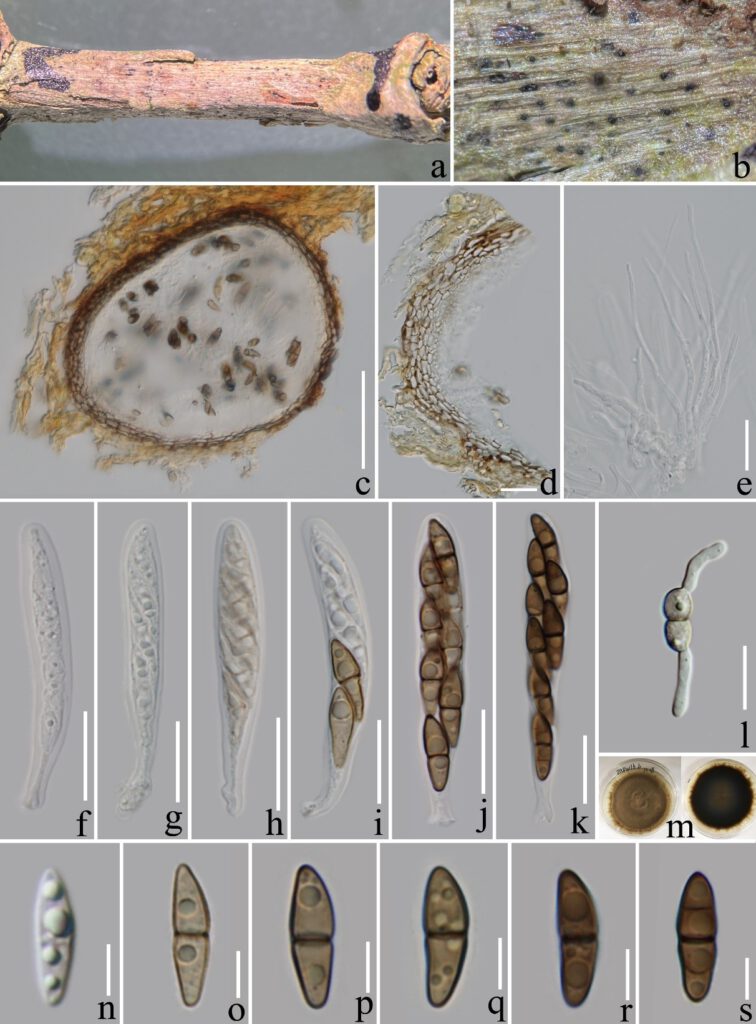Nigrograna coffeae L. Lu, K.D. Hyde & Tibpromma, sp. nov. (Figure 2)
MycoBank number: MB; Index Fungorum number: IF; Facesoffungi number: FoF 12765;
Etymology: Species epithet refers to the host “coffee” where the fungus was isolated
Holotype: ZHKU 22-0121
Saprobic on decaying branch of Coffea arabica. Sexual morph: Ascomata 90–140 µm high, 140–200 μm wide (x̅ = 115×168 μm, n = 10), immersed, solitary, black spots on substrate, subglobose to oval, or obpyriform, some with ostiolate. Peridium 10–15 µm wide, composed of 3–5 layers, hyaline to brown cells of textura angularis. Hamathecium 1.5–3 μm wide, composed of numerous, hyaline, filamentous, septate and branched pseudoparaphyses. Asci 50–70 × 7–11 μm (x̅ = 58 × 9 μm, n = 20), 8-spored, bitunicate, fissitunicate, clavate to cylindric-clavate, short stalked, some with club-shape pedicel, apically rounded, with a small ocular chamber. Ascospores 12–16 × 4–5 μm, (x̅ = 14.4 × 4.6 μm, n = 30), overlapping uni- to bi-seriately arranged, fusiform, straight or slightly curved, hyaline when immature and become yellowish-brown to dark-brown when mature, most of 1-septate, few 3-septate, constricted at each septum, with obviously guttulate. Asexual morph: Undetermined.
Culture characteristics: Ascospores germinating on PDA within 24 h and germ tubes arising from both ends. Colonies on PDA, reaching 4.5 cm diam. after two months of incubation at room temperature (22–26℃), initially white becoming grey to brown at maturity, dense, circular, slightly raised, surface smooth, radially fimbriate at edge, reverse dark green to brown.
Material examined: Pu’wen town, Xishuangbanna, Yunnan Province, China, on decaying branch of Coffea arabica, (101°2’44” E, 22°31’18” N, 856.89 m), 15 September 2021, LiLu, JHPW16 (ZHKU 22-0121), ZHKUCC 22-0210 = ZHKUCC 22-0211. GenBank number; ITS: ***, LSU: ***, rpb2: ***, SSU: ***, tef1-α: *** (ZHKUCC ***); ITS: ***, LSU: ***, rpb2: ***, SSU: ***, tef1-α: *** (ZHKUCC ***).
Notes: Our phylogenetic analyses showed that Nigrograna coffeae forms an independent clade (ML 100%, BYPP 1.00), and is phylogenetically related to N. yasuniana and N. jinghongensis. Nigrograna yasuniana was reported as endophytes from Conceveiba guianensis in Ecuador, but there were not enough morphological data. The comparison of base pairs in ITS showed 3.4 % differences (15/433 bp), LSU showed 1.5% differences (12/812bp), SSU only showed 0.3% differences (3/1028 bp), rpb2 showed 14% differences (117/829 bp), and tef1-α showed 3.2% differences (31/954 bp) (Kolařík et al. 2017). Nigrograna jinghongensis was introduced as a saprobic fungus from woody litter in China, and our new isolate shares a similar size (12–16 × 4–5 μm vs 12–15 × 4–5.5 µm) and color (hyaline to dark brown vs yellowish-brown to brown) of ascospores with N. jinghongensis (Boonmee et al. 2021), but there are some significant differences in the size of the ascomata (90–140 µm high, 140–200 μm wide vs 300–400 µm high 220–300 μm wide) and the shape of ascospores (fusiform, straight or slightly curved vs ellipsoid) (Boonmee et al. 2021). Based on the sequence blast results, ITS, LSU and rpb2 gene sequences were similar to Nigrograna sp., with 97.5% (MZ270683), 98.4% (MK762716), and 86% (MZ508421) respectively, SSU was similar to N. mycophile with 99% (KX650510), and TEF was similar to N. yasuniana with 96.6% (LN626670). Therefore, we introduce our new isolate as a new species N. coffeae based on both morphological characteristics and phylogenetic analyses results.

Figure 2. Nigrograna coffeae (ZHKU 22-0121, holotype). a, b Ascomata on the host substrate. c A vertical section through an ascoma. d Cells of peridium. e Hamathecium. f–k Asci. l A germinating ascospore. m Colonies on PDA. n–s Ascospores. Scale bars: c = 50 μm, d–l = 10 μm, n–s = 5 μm.
